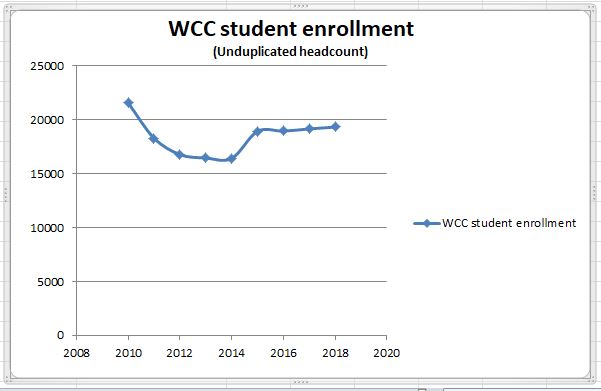I want to come back to this clip because it illustrates how deceptive the WCC administration is being with regard to the need for additional revenue.
Factually, the unduplicated headcount shows that WCC’s enrollment has been stable-to-slightly-increasing for several years. These figures come from the Center for Educational Performance and Information (CEPI) at the State of Michigan.

Let’s take a look at what she says:
“…the enrollment is not going to be where it always has been.”
She does not say that the enrollment is declining. (She can’t because it’s not.) But she clearly wants you to believe that WCC has fewer students than it has had in the past.
“RB: – Right now the community colleges – well, first – and number two, my second point I want to make, is that we are going to need to bring in some additional revenue, so that – in addition to our tax base- so that we can provide the quality of programming that we are – that we want to continue to provide for our students. And you can imagine the increasing technology costs – I mean – and … and what lies ahead of us.”
Then she attempts to make a general statement about community colleges, without acknowledging that the statement does not apply to Washtenaw Community College. She makes a fanciful statement about increasing technology costs and the future, asking the listener to fill in the blanks for her.
What does WCC need additional revenue for?
Factually, the Washtenaw County tax base provides the third-highest funding for any Michigan community college. Only Oakland CC and Wayne County Community College generate more property tax revenue than WCC does. This is a function of the property values in these counties and the size of these districts. Unless something happens to the property values here, WCC’s property tax revenues will continue to rise, regardless of how many students enroll.
First, if fewer students enroll (as she would like you to believe), there will actually be MORE MONEY per student to spend on programming.
Second, she implies that WCC’s spending priority is not student programming, which should be a problem for everyone. Effectively, what she says is this:
To finance student programming, we need additional money. If we can get additional money, we can finance student programming. If we can’t, student programming will have to be cut because other expenditures take priority over student programming.
WCC is an educational institution. Cuts to educational programming should be a last resort. They should never be considered until all other spending cuts have been made and there is nothing left to cut.
RB: – In order to do that, we have to look at some other revenue options. And the – the comm – the colleges – the community colleges that are – there are two in particular that are extremely well positioned now, regardless of their enrollment, and that’s Schoolcraft College, as I know Dianna knows from our – from MCCA, where that – sorry that president through the years has invested in mixed-use opportunities for his college, so he has revenue coming in.
RB: – The other is Macomb Community College, and that president, the one I worked with, um, had – I mean – we own everything around – on Garfield. And all of that mixed use, you know, land brings in revenue to the College. And so, they don’t really have to worry too much about their enrollment, because they have other ways to bring in revenue to support their college.
Other Revenue
Then she brings up the examples of Schoolcraft College and Macomb Community College. She wants you to believe that their “other revenue” carries them through student enrollment declines. So, naturally here’s where the wheels fall off.
Using CEPI data from FY2019, the most recent complete fiscal year, the top 5 “other revenue” earners among Michigan community colleges are:
| Community College | Other revenue |
|---|---|
| Macomb CC | $16,649,568.00 |
| Oakland CC | $15,794,028.00 |
| Washtenaw CC | $8,394,811.00 |
| Schoolcraft College | $6,663,921.00 |
| Lansing CC | $6,561,693.00 |
WCC takes in 26% more “other revenue” than Schoolcraft College does. WCC already does a better job of earning “other revenue” than one of her example schools. We have nothing to learn from Schoolcraft College. We already outperform them in terms of generating additional revenue.
While Macomb Community College takes in twice as much “other revenue” as WCC does, it also takes in nearly 27% less property tax revenue than WCC does. Perhaps MCC generates additional revenue because it needs additional revenue. WCC’s property tax revenues already more than make up for any additional revenue that WCC might (inconceivably) need.
Macomb Community College isn’t Washtenaw Community College
“- The other is Macomb Community College, and that president, the one I worked with, um, had – I mean – we own everything around – on Garfield.”
Before I address the real issue, who exactly is “we?”
It seems as though the WCC president – who has drawn a paycheck from Washtenaw County taxpayers since 2011 – is still stuck on working at Macomb Community College. By itself, that is offensive. It also demonstrates that even after eight-and-a-half years, she has no loyalty to the people who underwrite her ample salary.
Second, Huron River Drive is not Garfield. It is never going to be Garfield. For starters, Garfield is a five-lane road outside of Macomb Community College. According to SEMCOG traffic counts, it carries three times as much traffic as Huron River Drive does. The properties along this stretch of Garfield are all zoned commercial. NONE of the properties on Huron River Drive are zoned to be commercial, and no one here wants Huron River Drive to become Garfield.
Especially if – as the WCC Master Plan Update – we’ll be putting in a massive pedestrian crossing on Huron River Drive to accommodate the hotel and convention center.
WCC is funded quite adequately today. Unfortunately, it operates under an administration that does not place the highest spending priority on instruction. Worse, it operates under a set of trustees who are seemingly OK with that.
Photo Credit: peasap, via Flickr

















